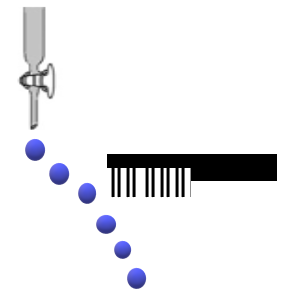
Consider the following compounds in the liquid form: \[{O_2},\,HF,\,{H_2}O,\,N{H_3},\,{H_2}{O_2},\,CC{l_4},\,CHC{l_3},\,{C_6}{H_6},\,{C_6}{H_5}Cl\]. When a charged comb is brought near their flowing stream, how many of them show deflection as per the following figure?

Answer
224.4k+ views
Hint: Electronegativity affects the molecules' polarity and nonpolarity. The more electronegative an atom is, it searches for electrons more actively. The concept of electronegativity is at play in the solution.
Complete Step by Step Solution:
The list of substances in the question is provided by:
\[{O_2},\,HF,\,{H_2}O,\,N{H_3},\,{H_2}{O_2},\,CC{l_4},\,CHC{l_3},\,{C_6}{H_6},\,{C_6}{H_5}Cl\]
The polar liquid is the only substance that is affected by a comb's charging because it contains molecules that have a dipole moment or an uneven charge distribution. Because most of the molecule's electrons are clustered around the oxygen molecules, a water molecule, for instance, has a substantial concentration of negative charge on its oxygen atoms.
The charge in the comb attracts a positive charge and repels a negative charge. Since each molecule in nonpolar liquids has an equal distribution of positive and negative charges, the ensuing attracting and repelling forces balance one another. Due to the unbalanced attractive and repulsive forces in polar liquids, which result from the uneven charge distribution in the liquid's molecules, the liquid will deflect when it comes into contact with an electric field.
\[\therefore \] Polarity of the molecules are: \[HF,\,{H_2}O,\,N{H_3},\,{H_2}{O_2},\,CHC{l_3},\,{C_6}{H_5}Cl\]
And, the non-polarity of the molecules are: \[{O_2},\,CC{l_4},\,{C_6}{H_6}\]
Thus, when a charged comb is brought near their flowing stream, six compounds will show deflection as per the figure.
Note: It should be noted that the polarity of water molecules is frequently demonstrated by the way an electric charge deflects a stream of water. As we all know, unless the charged rod is sufficiently close to the point where the stream becomes discontinuous, no deflection happens if the water turns into a stream of individual drops. Even though mercury atoms are non-polar, a charged comb would deflect a continuous stream of mercury. A charged comb does not deflect a flow of non-polar molecules.
Complete Step by Step Solution:
The list of substances in the question is provided by:
\[{O_2},\,HF,\,{H_2}O,\,N{H_3},\,{H_2}{O_2},\,CC{l_4},\,CHC{l_3},\,{C_6}{H_6},\,{C_6}{H_5}Cl\]
The polar liquid is the only substance that is affected by a comb's charging because it contains molecules that have a dipole moment or an uneven charge distribution. Because most of the molecule's electrons are clustered around the oxygen molecules, a water molecule, for instance, has a substantial concentration of negative charge on its oxygen atoms.
The charge in the comb attracts a positive charge and repels a negative charge. Since each molecule in nonpolar liquids has an equal distribution of positive and negative charges, the ensuing attracting and repelling forces balance one another. Due to the unbalanced attractive and repulsive forces in polar liquids, which result from the uneven charge distribution in the liquid's molecules, the liquid will deflect when it comes into contact with an electric field.
\[\therefore \] Polarity of the molecules are: \[HF,\,{H_2}O,\,N{H_3},\,{H_2}{O_2},\,CHC{l_3},\,{C_6}{H_5}Cl\]
And, the non-polarity of the molecules are: \[{O_2},\,CC{l_4},\,{C_6}{H_6}\]
Thus, when a charged comb is brought near their flowing stream, six compounds will show deflection as per the figure.
Note: It should be noted that the polarity of water molecules is frequently demonstrated by the way an electric charge deflects a stream of water. As we all know, unless the charged rod is sufficiently close to the point where the stream becomes discontinuous, no deflection happens if the water turns into a stream of individual drops. Even though mercury atoms are non-polar, a charged comb would deflect a continuous stream of mercury. A charged comb does not deflect a flow of non-polar molecules.
Recently Updated Pages
JEE Main 2026 Session 1 Correction Window Started: Check Dates, Edit Link & Fees

JEE Isolation, Preparation and Properties of Non-metals Important Concepts and Tips for Exam Preparation

Isoelectronic Definition in Chemistry: Meaning, Examples & Trends

Ionisation Energy and Ionisation Potential Explained

Iodoform Reactions - Important Concepts and Tips for JEE

Introduction to Dimensions: Understanding the Basics

Trending doubts
JEE Main 2026: City Intimation Slip and Exam Dates Released, Application Form Closed, Syllabus & Eligibility

JEE Main 2026 Application Login: Direct Link, Registration, Form Fill, and Steps

Understanding the Angle of Deviation in a Prism

How to Convert a Galvanometer into an Ammeter or Voltmeter

Hybridisation in Chemistry – Concept, Types & Applications

Ideal and Non-Ideal Solutions Explained for Class 12 Chemistry

Other Pages
JEE Advanced Marks vs Ranks 2025: Understanding Category-wise Qualifying Marks and Previous Year Cut-offs

Thermodynamics Class 11 Chemistry Chapter 5 CBSE Notes - 2025-26

Organic Chemistry Some Basic Principles And Techniques Class 11 Chemistry Chapter 8 CBSE Notes - 2025-26

JEE Advanced 2026 - Exam Date (Released), Syllabus, Registration, Eligibility, Preparation, and More

JEE Advanced 2026 - Exam Date (Released), Syllabus, Registration, Eligibility, Preparation, and More

Hydrocarbons Class 11 Chemistry Chapter 9 CBSE Notes - 2025-26




